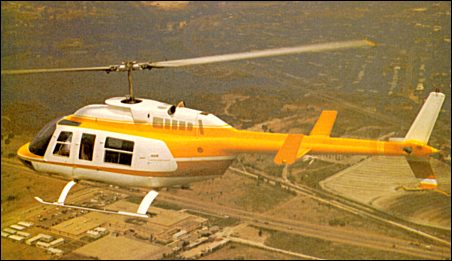
| Bell 206L "Long Ranger" 1963 |  |
 |

| Bell 206L "Long Ranger" 1963 |  |
 |
|
The capability and reliability of the JetRanger family resulted in Bell developing a medium-lift version under the designation Model 206L LongRanger. This had the powerplant of the JetRanger III, and a fuselage lengthened by 0.63m to accommodate a total of five passengers. With a capacity of 2.35m3, the LongRanger clearly had good freight-carrying capability, and to simplify the loading of bulky items a double door was incorporated in the port side of the fuselage. Other improvements included the use of an advanced main rotor, plus introduction of the company's patented Noda-Matic suspension system which gives much lower cabin vibration levels. Deliveries of production LongRangers began in October 1975, but this was superseded by the Model 206L LongRanger II in mid-1978. The LongRanger II differs by having the more powerful Allison 250C-28B turboshaft with a maximum continuous rating of 365kW, a higher-rated transmission, and detail improvements. During 1981 the company developed the improved LongRanger III which has the 485kW Allison 250-C30P engine and numerous small changes. It is currently in production at Bell's plant at Mirabel in Canada. Subsequently, Bell initiated development of a multi-role military variant of the commercial LongRanger under the designation Model 206L TexasRanger. The Model 406 is a derivative using a new four-blade rotor, a conversion of OH-58As to provide the US Army with enhanced scout helicopters under the designation OH-58D. Featuring a mast-mounted sight, these have an Allison 250-C30R engine of 485kW rating. The first conversion flew on 6 October 1983, and deliveries to the US Army of 578 such aircraft is under way. Among these are some AH-58D Warrior armed examples. In late 1989, overall production by Bell of members of the Model 206 family was considerably in excess of 7,000. Agusta, in Italy, has also produced JetRangers and LongRangers under licence from Bell, these being generally similar to their American counterparts. D.Donald "The Complete Encyclopedia of World Aircraft", 1997
First announced in September 1973, the Long Ranger was developed to meet a requirement for a turbine-powered general-purpose helicopter in a size and performance range between the five-seat Jet Ranger II and 15-seat Model 205A-1. The original Model 206L Long Ranger flew for the first time on 11 September 1974 and production aircraft were delivered from October 1975. It incorporated Bell's Noda-Matic cabin suspension system, which reduces rotor-induced vibration and isolates structure-borne noise from the cabin environment. Accommodation provided for a pilot, co-pilot and five passengers. Alternative layouts allow for two stretchers and two ambulatory patients/attendants, or internal or external freight, or a four-seat executive seating arrangement. The new Model 206L-1 Long Ranger II was certificated in May 1978, introducing a new 500shp Allison 250-C28B engine. Detail improvements include a redesigned aft cabin to provide 0.05m more headroom for rear seat passengers, new cowlings, firewall, engine mountings and engine deck area structure and other refinements. Deliveries of the Model 206L and L-1 were expected to reach 230 by the beginning of 1979. M.Taylor "Jane's Encyclopedia of Aviation", 1989
PROGRAMME: Stretched JetRanger. LongRanger announced 25 September 1973; first flight 11 September 1974; initial versions were 206L and 206L-1 LongRanger II, of which 790 built; limited production (17) of 206L-2; replaced by 206L-3 LongRanger III in 1982, of which 612 built, production having transferred to Canada in January 1987. CURRENT VERSIONS:
CUSTOMERS: Over 1,700 LongRangers produced by late 2002, including 275 LongRanger IVs and 206LTs. Recent customers include Air Logistics of New Iberia, Louisiana. which ordered 14 on 26 March 2003 for delivery between second quarter 2003 and 2005. Total of 12 delivered in 1999, 27 in 2000, 10 in 2001 and 12 in 2002. DESIGN FEATURES: As JetRanger, but cabin length increased to make room for club seating and extra window; Bell Noda- Matic transmission to reduce vibration; vertical stabilisers added to horizontal tail surfaces. Improvements introduced on LongRanger II include new freewheel unit, modified shafting and increased-thrust tail rotor; main rotor rpm 394; rotor brake optional. FLYING CONTROLS: AS Jet Ranger, but with endplate fins on Tailplane; single-pilot IFR with Rockwell Collins AP-107H autopilot; optional SFENA autopilot with stabilisation and holds for heading, height and approach. STRUCTURE: As JetRanger. LANDING GEAR: As JetRanger. POWER PLANT: One 485kW Rolls-Royce 250-C30P turboshaft (maximum continuous rating 415kW). Transmission rated at 365kW for take-off, with a continuous rating of 276kW; 340kW transmission optional. Rupture-resistant fuel system, composing three interconnected cells, total usable capacity 419 litres. ACCOMMODATION: Redesigned rear cabin, more spacious than JetRanger. With a crew of two, standard cabin layout accommodates five passengers in two canted rearward-facing seats and three forward-facing seats. Optional DeLuxe and Custom DeLuxe interiors with fabric, fabric/vinyl, all vinyl or fabric/leather seats. Port forward passenger seat has folding back to allow loading of a 2.44 x 0.91 x 0.30m container, making possible carriage of such items as survey equipment, skis and other long components. Double doors on port side of cabin provide opening 1.55m wide, for straight-in loading of stretcher patients or utility cargo; in ambulance or rescue role two stretcher patients and two ambulatory patients/attendants can be carried. Dual controls optional. SYSTEMS: Hydraulic system; 28V DC electrical power from 180A starter/generator and 17Ah battery. Engine bleed air ECS optional. AVIONICS; Comms: Bendix/King suite includes dual nav/com and transponder. Flight: ADF, DME and marker beacon receiver. Honeywell R/Nav, radio altimeter and encoding altimeter optional. EQUIPMENT: Optional kits include emergency flotation gear. 907kg cargo hook, rescue hoist, Nightsun searchlight (requires high skid gear). Jane's All the World's Aircraft, 2004-2005
|